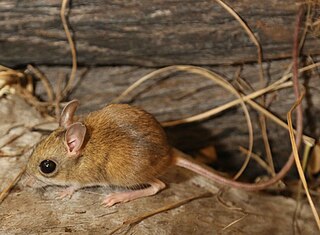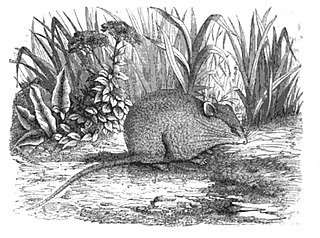
A hopping mouse is any of about ten different Australian native mice in the genus Notomys. They are rodents, not marsupials, and their ancestors are thought to have arrived from Asia about 5 million years ago.

The spinifex hopping mouse, also known as the tarkawara or tarrkawarra, occurs throughout the central and western Australian arid zones, occupying both spinifex-covered sand flats and stabilised sand dunes, and loamy mulga and melaleuca flats.
The big-eared hopping mouse is an extinct species of mouse, which lived in the Moore River area of south-western Australia. The big-eared hopping mouse was a small, rat-sized animal resembling a tiny kangaroo. It had large eyes and ears with a brush-tipped tail. It moved on its four legs when traveling at a slower pace, or by bounding upon its enlarged, padded, hind feet when traveling quickly. They mainly lived in sand dunes and made nests of leaves and other organic materials. The big-eared hopping-mouse was last collected in July 1843 near the Moore River, Western Australia, close to where New Norcia is now situated, and has not been seen since.

Gould's mouse, also known as the Shark Bay mouse and djoongari in the Pintupi and Luritja languages, is a species of rodent in the murid family. Once ranging throughout Australia from Western Australia to New South Wales, its range has since been reduced to five islands off the coast of Western Australia.
The short-tailed hopping mouse is an extinct species of mouse from open stony (gibber) plains with desert grasses, low shrubs and sand ridges in the area around Charlotte Waters, near Alice Springs in Central Australia. It weighed 80 grams. The last record is from June 1896. Only two complete specimens were collected, probably from Aboriginal Australians. It was among the largest of all Australian hopping mice recorded in Australia; it was twice as heavy as any living species of hopping mice, although fossils suggest the extinct great hopping mouse may have been a similar size. The short-tailed hopping mouse was predominantly brown in colour, its tail probably being as long as its body. This species' decline was due to a number of factors, some of which were being hunted by predators such as foxes, cats and habitat alterations.

The mountain beaver is a North American rodent. It is the only living member of its genus, Aplodontia, and family, Aplodontiidae. It should not be confused with true North American and Eurasian beavers, to which it is not closely related; the mountain beaver is instead more closely related to squirrels, although its less-efficient renal system was thought to indicate greater relative antiquity for the species. There are seven subspecies of mountain beavers, six of which are found in California and three of which are endemic to the state.

Pseudomys is a genus of rodent that contains a wide variety of mice native to Australia and New Guinea. They are among the few terrestrial placental mammals that colonised Australia without human intervention.
Notiomys edwardsii, also known as Edwards's long-clawed mouse, Edward's long-clawed akodont, or Milne-Edwards' long-clawed mouse, is a rodent in the tribe Abrotrichini from southern Argentina. It is the only species in the genus Notiomys, although species of Chelemys and Geoxus were formerly included in that genus.

Mitchell's hopping mouse also known as the pankot, is the largest extant member of the genus Notomys, weighing between 40 and 60 g. N. mitchellii is a bipedal rodent with large back legs, similar to a jerboa or kangaroo rat. The species occurs throughout much of semi-arid Southern Australia, and appears to be particularly common on the Eyre Peninsula, South Australia. Typical habitat for N. mitchellii appears to be mallee shrublands on sandy dune systems. The species is currently considered to be unthreatened, but its range has been reduced through habitat disturbance and destruction associated with European settlement in Australia.
Irenomys tarsalis, also known as the Chilean climbing mouse, Chilean tree mouse, or long-footed irenomys, is a rodent found in Chile, from about 36° to 46°S, and in adjacent Argentina, mainly in forests. It is a large, long-tailed, soft-furred mouse characterized by grooved upper incisors and specialized molars with transverse ridges, divided by deep valleys, which are connected by a transverse ridge along the midline of the molars.
The Forrest's mouse, or desert short-tailed mouse, is a small species of rodent in the family Muridae. It is a widespread but sparsely distributed species found across arid and semi-arid inland Australia, commonly found in tussock grassland, chenopod shrubland, and mulga or savannah woodlands.

The northern hopping mouse is a species of rodent in the family Muridae. It is found only in coastal northern Australia, from Arnhem Land to the Cobourg Peninsula.

The ash-grey mouse is a rodent in the family Muridae. Larger and more robust than Mus musculus, the common house mouse, it is found only in Southwest Australia.
The great hopping mouse is an extinct species of mammal native to Australia. It is known only from skulls found in owl pellets in the Flinders Ranges. Some pellets also include bones of the introduced house mouse—indicating that it survived into historic times, possibly the second half of the 19th century. From the skull, it appears to have been relatively large and to have escaped collection by early 19th century naturalists by chance. From the location of the deposits it is assumed that it preferred clay rather than sandy soils. It is also commonly known as the broad-cheeked hopping mouse.
N. robustus may refer to:

The fawn hopping mouse is a medium sized rodent endemic to the Channel Country Bioregion of northeast South Australia and southwest Queensland in Australia. They inhabit open gibber (stony) and clay plains of the Lake Eyre basin. While the population and distribution has been greatly reduced since European settlement, the current population shows little evidence of significant decline and is consequently listed as 'Near Threatened'.

Hydromyini is a very large, diverse tribe of muroid rodents in the subfamily Murinae. They are the dominant native rodents in Australasia and one of only two native rodent groups there, the other being the R. fuscipes group of the genus Rattus in the tribe Rattini. They are also found in parts of Southeast Asia.











